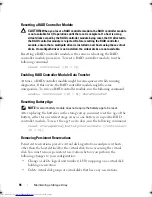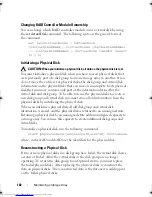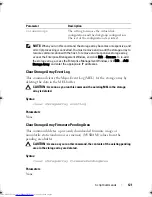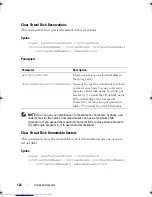
Script Commands
107
To use the
raidLevel
parameter to set a RAID level of
5
, enter:
raidLevel=5
• When you specify physical disk locations by using enclosure ID values and
slot ID values, separate the ID values with a comma. If you enter more
than one set of ID values, separate each set of values by a space. Put
parentheses around the set of values. For example:
(0,0 0,1 0,2 0,3 1,0 1,1 1,2 1,3)
• Italicized terms in the command indicate a value or information that you
need to provide. For example, when you encounter the italicized term:
numberOfPhysicalDisks
Replace the italicized term with a value for the number of physical disks
that you want to include with the command.
• You can use any combination of alphanumeric characters, hyphens, and
underscores for the names of the following components:
–
Storage arrays
–
Host groups
–
Hosts
–
Disk groups
–
Virtual disks
–
Host bus adapter (HBA) host ports
Names can have a maximum of 30 characters. If the label contains
multiple words, underscores, or hyphens, you must put quotation marks
around the name. In some usages you must also put brackets around the
name. The description of each parameter tells you if you must put
quotation marks or brackets around a parameter value. The character
string cannot contain a new line. You must use unique names or the RAID
controller module firmware returns an error.
NOTE:
You can use any combination of alphanumeric characters, hyphens, and
underscores for the names. Command names can have a maximum of 30
characters. If you exceed the maximum character limit, replace square brackets
([ ]) with angle brackets (< >) to overcome this limitation.
book.book Page 107 Friday, March 4, 2011 10:45 AM
Summary of Contents for PowerVault MD3200 Series
Page 1: ...Dell PowerVault Modular Disk Storage Arrays CLI Guide ...
Page 42: ...42 About the Script Commands ...
Page 263: ...Script Commands 263 ...
Page 269: ...268 Sample Script Files ...
Page 271: ...270 CLI Command Updates ...
Page 279: ...Index 278 ...
















































